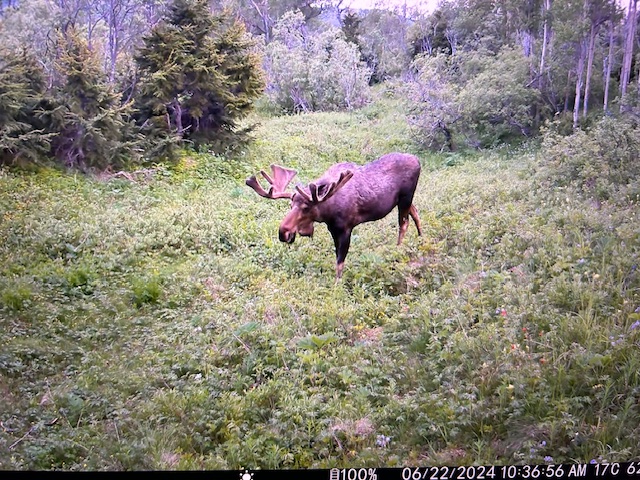Alaska
Federal bill would add veterinary care to IHS duties to address rabies, other risks in rural Alaska

The Indian Health Service provides medical and dental care to the Indigenous peoples of Alaska and elsewhere in the nation. What it does not provide, however, is veterinary care for animals living with the IHS’ human clients.
A bill introduced by Sen. Lisa Murkowski, R-Alaska, is an attempt to change that.
The bill, called the Veterinary Services to Improve Public Health in Rural Communities Act, was introduced by the Alaska senator last week. It would add veterinary services to the federal agency’s duties. That is important in rural Alaska, she said, where regular veterinarian care is notoriously scarce and where diseases in wild animal populations pose threats to domestic animals like dogs and, potentially, people.
The bill would direct the IHS to work with tribal organizations to provide veterinarian services, including spaying and neutering of pets.
A top concern is rabies, which is common in Alaska fox populations but also found in other animals and thus poses risks to people.
“Unfortunately, in Alaska we are experiencing more frequent rabies outbreaks in wild animal populations. Rural communities are disproportionately at higher risk of rabies transmission to humans due to uncontrolled dog populations in remote areas of Alaska — which is particularly concerning given the challenges of providing health care in many rural and remote villages,” Murkowski said in a statement. There are vaccination and voluntary veterinary services trying to address the problems, but those “are simply not able to meet the growing need for services. My bill would help bolster the veterinary workforce in Alaska, creating healthier and safer communities across the state,” she said.
Alaska Native children, research shows, are at elevated risks for dog bites, which could, in turn, expose them to rabies or other diseases that can spread between animals and people, also known as zoonotic diseases. A 2013 study by the Centers for Disease Control and Prevention found that Alaska Native children’s rate of hospitalization for dog bites was about twice that of the general U.S. child population. Indigenous children in the Southwestern and Northern Plains states also had high rates of hospitalization for dog bites, the study found.
Dog bites and exposure through them to rabies and other diseases is a problem in Indigenous communities throughout the circumpolar north, and “dog bites have become an important public health burden” in those places, said a 2022 report by Canadian researchers that synthesized 257 individual studies.
Rabies is endemic, meaning entrenched, in the Arctic fox and red fox populations of northern Alaska, Western Alaska and the Aleutians, according to the Alaska Department of Fish and Game. But rabies has been found in other wild animals, such as caribou and polar bears, according to the department.
Last summer, North America’s first confirmed case of a rabies-infected moose occurred in the Bering Strait-area village of Teller. The moose, found wandering in and around the community, was euthanized and found to be carrying the Arctic fox variant of the rabies virus, which is different from the red fox variant, the Department of Fish and Game said.
Among the provisions in Murkowski’s bill is a directive for the veterinary officers from the U.S. Public Health Service Commissioned Corps to provide services to the IHS, a directive for a study about the feasibility of delivering oral rabies vaccines in Alaska’s Arctic region and inclusion of the IHS as a coordinating agency in the National One Health Framework, which is addressing zoonotic diseases and federal agencies’ readiness to respond to them.

Alaska
Rural Alaska schools face funding shortfall after U.S. House fails to pass bipartisan bill • Alaska Beacon
Rural schools, mostly in Southeast Alaska, are facing a major funding shortfall this year after the U.S. House of Representatives failed to reauthorize a bill aimed at funding communities alongside national forests and lands.
The bipartisan Secure Rural Schools and Community Self-Determination Act was first passed in 2000, and enacted to assist communities impacted by the declining timber industry. It provided funds for schools, as well as for roads, emergency services and wildfire prevention. The award varies each year depending on federal land use and revenues. The legislation is intended to help communities located near federal forests and lands pay for essential services. In 2023, the law awarded over $250 million nationwide, and over $12.6 million to Alaska.
But this year, the bill passed the Senate, but stalled in the House of Representatives amid partisan negotiations around the stopgap spending bill to keep the government open until March. House Republicans decided not to vote on the bill amid a dispute around health care funding, a spokesperson for the bill’s sponsor, Oregon Sen. Ron Wyden, told the Oregon Capital Chronicle, which first reported the story.
Eleven boroughs, as well as unincorporated areas, in the Tongass and Chugach national forests have typically received this funding, awarded through local municipalities. According to 2023 U.S. Forest Service data, some of the districts who received the largest awards, and now face that shortfall, include Ketchikan, Wrangell, Petersburg, Sitka and Yakutat, as well as the unincorporated areas.
“We’re already at our bottom,” said Superintendent Carol Pate of the Yakutat School District, which received over $700,000 in funding, one of the largest budget sources for its 81 students.
“We are already down to one administrator with six certified teachers,” Pate said in a phone interview Thursday. “We have a small CTE (career and technical education) program. We don’t have any art, we don’t have any music. We have limited travel. Anything that we lose means we lose instruction, and our goal is for the success of our students.”
Yakatat is facing a $126,000 deficit this year, a large sum for their $2.3 million budget, Pate said. “So that’s a pretty significant deficit for us. We do our best to be very conservative during the school year to make up that deficit. So wherever we can save money, we do.”
The school has strong support from the borough, Pate said. However, last year they were forced to cut funding for one teacher and a significant blow for the school, she said.
“We’re trying very hard to break the cycle, but it’s a continuing cycle,” she said. “Every time we lose something, we lose kids because of it, and the more kids we lose, the more programs we lose.”
In the southern Tongass National Forest community of Wrangell, the school district received over $1 million in funds last year, and Superintendent Bill Burr said the federal funding loss is dramatic.
“It’s pretty devastating from a community standpoint,” Burr said in a phone interview. “Because that is very connected to the amount of local contribution that we get from our local borough, it has a dramatic effect on the school district, so I’m disappointed.”
“As these cuts continue to happen, there’s less and less that we’re able to do,” he said. “School districts are cut pretty much as thin as they can. So when these things happen, with no real explanation, the impact for districts that do receive secure schools funding is even more dramatic.”
Whether and how the funding loss will impact the district has yet to be determined, as budgets for next year are still in development, Burr said, but it could mean cuts to matching state grants, facilities projects, or staff salaries. He said most non-state money for the district comes from the federal program.
“Part of our funding does come from sales tax, but a majority of it comes from the secure rural schools (grant),” he said. “So without increases in other areas, the amount of money that can come to the schools is going to be injured.”
“We do have contracts, and a majority of our money is paid in personnel. So we would have those contracts to fill, regardless of the funding, until the end of the year. A major reduction really will affect our ability to provide school services and personnel, so it could have a massive impact on next year’s, the fiscal ‘26 year, budget,” he said.
The district is facing an over $500,000 budget deficit this year, Burr said, and so the loss puts further pressure on the district.
“So we’re continuing to find areas that we can cut back but still provide the same service. But that’s getting harder and harder,” he said.
The schools in unincorporated areas known as regional educational attendance areas, received over $6 million in funding through the program.
Alaska Sens. Lisa Murkowski and Dan Sullivan supported the bill through the Senate.
Murkowski was disappointed that the bill was not reauthorized, a spokesperson for the senator said.
“As a longtime advocate for this program, she recognizes its critical role in funding schools and essential services in rural communities,” said Joe Plesha, in a text Friday. “She is actively working to ensure its renewal so that states like Alaska are not disadvantaged.”
Former Alaska Rep. Mary Peltola also supported the funding.
Alaska’s school funding formula is complex, and takes into account the local tax base, municipalities’ ability to fund schools, and other factors. With the loss of funding for the local borough’s portion, whether the Legislature will increase funding on the state’s side is to be determined.
The Department of Education and Early Development did not respond to requests for comment on Friday.
Superintendents Burr and Pate described hope for the upcoming legislative session, and an increase in per-pupil spending. “The loss of secure rural schools funding makes it even more difficult to continue with the static funding that education in the state has received,” Burr said.
“I really have high hopes for this legislative season. I think that the people that we’ve elected recognize the need to put funding towards education,” Pate said.
The funding could be restored, if the legislation is reintroduced and passed by Congress. Both Oregon Democratic Sen. Wyden and Idaho Republican Sen. Mike Crapo have said they support passing the funding this year.
YOU MAKE OUR WORK POSSIBLE.
Alaska
Raised In Alaska Spotting Moose And Grizzly On Trail Cameras

We’re sharing some of the Last Frontier adventures of the popular YouTube account Raised In Alaska. This week: Moose and grizzly trail camera shots.
Subscribe to Raised In Alaska on YouTube. Follow on X, formerly known as Twitter (@akkingon).
Alaska
Fatal vehicle collision left one dead, two injured at mile 91 of Seward Highway, APD says

ANCHORAGE, Alaska (KTUU) – On Thursday, a vehicle collision at mile 91 of the Seward Highway left one dead and two injured, according to an update from APD.
The collision involved two vehicles — a semi-truck and a passenger vehicle.
The Girdwood Fire Department responded at about 8:41 p.m. and pronounced the male driver of the vehicle dead at the scene.
APD says a male and female were transported to the hospital with non-life-threatening injuries.
At the time of publication, the southbound and northbound lanes of the Seward Highway remain closed.
APD is currently investigating the circumstances of the collision and the victim’s identity will be released once they have completed next-of-kin procedures.
Original Story: An incident involving two vehicles at mile 91 of Seward Highway leaves two injured, according to Anchorage Police Department (APD).
APD is responding to the scene and travelers should expect closures at mile 91 for both northbound and southbound lanes of the Seward Highway for at least the next 3 to 4 hours.
Updates will be made as they become available.
See a spelling or grammar error? Report it to web@ktuu.com
Copyright 2025 KTUU. All rights reserved.
-

 Business1 week ago
Business1 week agoThese are the top 7 issues facing the struggling restaurant industry in 2025
-

 Culture1 week ago
Culture1 week agoThe 25 worst losses in college football history, including Baylor’s 2024 entry at Colorado
-

 Sports1 week ago
Sports1 week agoThe top out-of-contract players available as free transfers: Kimmich, De Bruyne, Van Dijk…
-

 Politics1 week ago
Politics1 week agoNew Orleans attacker had 'remote detonator' for explosives in French Quarter, Biden says
-

 Politics1 week ago
Politics1 week agoCarter's judicial picks reshaped the federal bench across the country
-

 Politics6 days ago
Politics6 days agoWho Are the Recipients of the Presidential Medal of Freedom?
-

 Health5 days ago
Health5 days agoOzempic ‘microdosing’ is the new weight-loss trend: Should you try it?
-

 World1 week ago
World1 week agoIvory Coast says French troops to leave country after decades



















